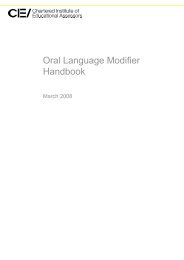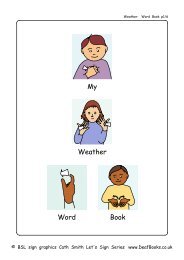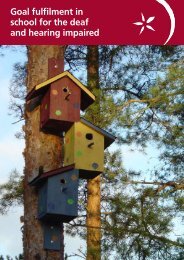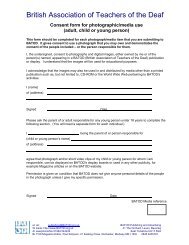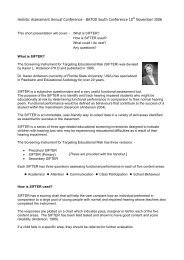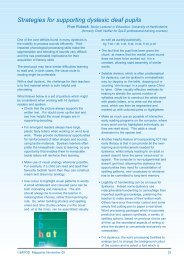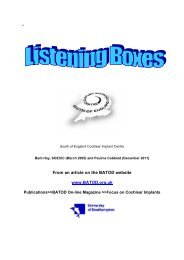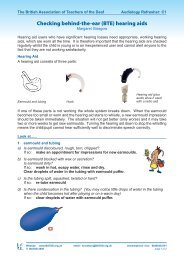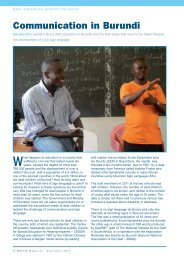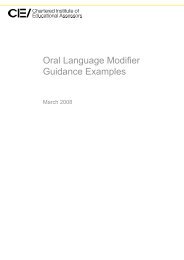Masking in pure tone audiometry - batod
Masking in pure tone audiometry - batod
Masking in pure tone audiometry - batod
Create successful ePaper yourself
Turn your PDF publications into a flip-book with our unique Google optimized e-Paper software.
The British Association of Teachers of the Deaf<br />
Audiology Refresher: T10<br />
<strong>Mask<strong>in</strong>g</strong> <strong>in</strong> <strong>pure</strong> <strong>tone</strong> <strong>audiometry</strong><br />
Sue Westhorp<br />
Purpose of the test<br />
The technique of mask<strong>in</strong>g is used <strong>in</strong> order to isolate the test ear and ensure that results<br />
obta<strong>in</strong>ed are the true thresholds of the test ear.<br />
In <strong>pure</strong> <strong>tone</strong> <strong>audiometry</strong> for both air conduction and bone conduction it is possible that<br />
responses obta<strong>in</strong>ed are those of the non-test ear.<br />
Rationale<br />
To establish the true threshold of detectability for air and bone conduction.<br />
Air conduction <strong>pure</strong> <strong>tone</strong> <strong>audiometry</strong><br />
It is possible for sounds <strong>in</strong>troduced <strong>in</strong>to the test ear via headphones to be carried by bone<br />
conduction across the skull and stimulate the cochlea of the non-test ear. The amount of<br />
sound energy that is lost as it crosses the skull is known as transcranial attenuation. It varies<br />
<strong>in</strong> <strong>in</strong>dividuals between 40 and 85 dB. It is accepted that if the difference <strong>in</strong> thresholds between<br />
the air conduction results at any frequency is 40dBHL or greater then it is possible that the<br />
response is due to stimulus of the non-test ear.<br />
When there is this difference of at least 40dBHL then mask<strong>in</strong>g is <strong>in</strong>troduced <strong>in</strong> order to isolate<br />
the test ear and obta<strong>in</strong> true thresholds.<br />
In mask<strong>in</strong>g a narrow band noise centred around the test frequency is <strong>in</strong>troduced <strong>in</strong>to the nontest<br />
ear. This noise “occupies” the non-test ear and allows the test ear to respond at its true<br />
threshold. Pure <strong>tone</strong>s are presented <strong>in</strong>to the test ear <strong>in</strong> the usual way until a true threshold<br />
can be recorded.<br />
<strong>Mask<strong>in</strong>g</strong> procedure <strong>in</strong> air conduction test<strong>in</strong>g (This is known as Hood’s technique)<br />
<br />
<br />
<br />
<br />
<br />
<br />
<br />
<br />
The procedure uses conventional headphones.<br />
The adult/child is asked to listen to the narrow band noise <strong>in</strong> the non-test ear and <strong>in</strong>dicate<br />
when it is just audible. Increase the level by 20dB. Instruct the adult/child to ignore this<br />
noise and listen for the signal.<br />
Us<strong>in</strong>g the usual 10 down 5 up method, re-measure the threshold of the test ear.<br />
Increase the mask<strong>in</strong>g level by 10dB.<br />
Re-measure the threshold.<br />
Repeat the process until for two successive <strong>in</strong>creases <strong>in</strong> mask<strong>in</strong>g level the threshold does<br />
not change.<br />
This gives the true air conduction threshold of the test ear.<br />
This technique is not recommended for very young children as they can f<strong>in</strong>d it difficult to<br />
understand what to do. Generally it can be done at around age seven.<br />
Website: www.BATOD.org.uk email: secretary@BATOD.org.uk Answerphone / fax: 08456435181<br />
© BATOD 2009 page 1 of 2
The British Association of Teachers of the Deaf<br />
Audiology Refresher: T10<br />
Figure 1 gives an example of mask<strong>in</strong>g be<strong>in</strong>g required for air conduction.<br />
The unmasked results show responses on the right at around 50dBHL and on the left around<br />
10dBHL. As there is a difference of 40dB it is possible that the orig<strong>in</strong>al responses recorded<br />
for the right are <strong>in</strong> fact the left cochlea respond<strong>in</strong>g.<br />
<strong>Mask<strong>in</strong>g</strong> is required to determ<strong>in</strong>e the true threshold on the right.<br />
Bone conduction <strong>pure</strong> <strong>tone</strong> <strong>audiometry</strong><br />
In bone conduction <strong>pure</strong> <strong>tone</strong> <strong>audiometry</strong> mask<strong>in</strong>g for bone conduction assessment is<br />
required when there is a gap at any frequency of 15dB or more between the unmasked bone<br />
conduction result and the air conduction threshold. This is known as the air-bone gap.<br />
Figure 2 shows an example of bone conduction results that require mask<strong>in</strong>g.<br />
Air conduction results show a mild hear<strong>in</strong>g loss <strong>in</strong> both ears. The unmasked bone <strong>in</strong>dicates<br />
normal cochlea function <strong>in</strong> at least one cochlea. With this result it is not possible to know if<br />
the right, left or both cochlea are giv<strong>in</strong>g this response. <strong>Mask<strong>in</strong>g</strong> is required to determ<strong>in</strong>e the<br />
response of each cochlea.<br />
<strong>Mask<strong>in</strong>g</strong> <strong>in</strong> bone conduction test<strong>in</strong>g<br />
The same method is used as for air conduction.<br />
<br />
<br />
The bone conduction vibrator is placed on the mastoid process of the test ear.<br />
<strong>Mask<strong>in</strong>g</strong> noise is <strong>in</strong>troduced to the non-test ear through an <strong>in</strong>sert earphone which is<br />
placed <strong>in</strong> the ear canal and held <strong>in</strong> place by a hook over the p<strong>in</strong>na. The <strong>tone</strong> is <strong>in</strong>troduced<br />
via headphone <strong>in</strong>to the test ear.<br />
Website: www.BATOD.org.uk email: secretary@BATOD.org.uk Answerphone / fax: 08456435181<br />
© BATOD 2009 page 2 of 2



